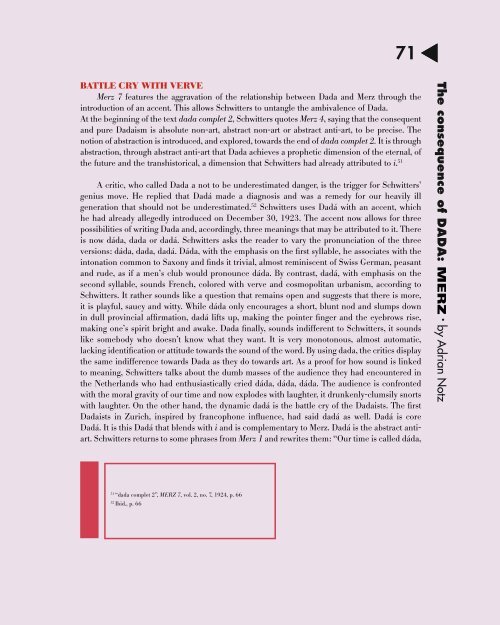Kurt Schwitters: Merz (2016) – Norman Rosenthal interviews Damien Hirst
Fully illustrated catalog published by Galerie Gmurzynska in collaboration with Cabaret Voltaire Zurich on the occasion of Kurt Schwitters: MERZ, a major retrospective exhibition celebrating 100 years of Dada. The exhibition builds and expands on the gallery’s five decade long exhibition history with the artist, featuring exhibition architecture by Zaha Hadid. Edited by Krystyna Gmurzynska and Mathias Rastorfer. First of three planned volumes containing original writings by Kurt Schwitters, historical essays by Ernst Schwitters, Ad Reinhardt and Werner Schmalenbach as well as text contributions by Siegfried Gohr, Adrian Notz, Jonathan Fineberg, Karin Orchard, and Flavin Judd. Foreword by Krystyna Gmurzynska and Mathias Rastorfer. Interview with Damien Hirst conducted by Norman Rosenthal. Includes full color plates and archival photographs. 174 pages, color and b/w illustrations. English. ISBN: 978-3-905792-33-1 The publication includes an Interview with Damien Hirst by Sir Norman Rosenthal about the importance of Kurt Schwitters's practice for Hirst's work.
Fully illustrated catalog published by Galerie Gmurzynska in collaboration with Cabaret Voltaire Zurich on the occasion of Kurt Schwitters: MERZ, a major retrospective exhibition celebrating 100 years of Dada. The exhibition builds and expands on the gallery’s five decade long exhibition history with the artist, featuring exhibition architecture by Zaha Hadid.
Edited by Krystyna Gmurzynska and Mathias Rastorfer.
First of three planned volumes containing original writings by Kurt Schwitters, historical essays by Ernst Schwitters, Ad Reinhardt and Werner Schmalenbach as well as text contributions by Siegfried Gohr, Adrian Notz, Jonathan Fineberg, Karin Orchard, and Flavin Judd.
Foreword by Krystyna Gmurzynska and Mathias Rastorfer.
Interview with Damien Hirst conducted by Norman Rosenthal.
Includes full color plates and archival photographs.
174 pages, color and b/w illustrations.
English.
ISBN:
978-3-905792-33-1
The publication includes an Interview with Damien Hirst by Sir Norman Rosenthal about the importance of Kurt Schwitters's practice for Hirst's work.
You also want an ePaper? Increase the reach of your titles
YUMPU automatically turns print PDFs into web optimized ePapers that Google loves.
t<br />
71<br />
t<br />
BATTLE CRY WITH VERVE<br />
<strong>Merz</strong> 7 features the aggravation of the relationship between Dada and <strong>Merz</strong> through the<br />
introduction of an accent. This allows <strong>Schwitters</strong> to untangle the ambivalence of Dada.<br />
At the beginning of the text dada complet 2, <strong>Schwitters</strong> quotes <strong>Merz</strong> 4, saying that the consequent<br />
and pure Dadaism is absolute non-art, abstract non-art or abstract anti-art, to be precise. The<br />
notion of abstraction is introduced, and explored, towards the end of dada complet 2. It is through<br />
abstraction, through abstract anti-art that Dada achieves a prophetic dimension of the eternal, of<br />
the future and the transhistorical, a dimension that <strong>Schwitters</strong> had already attributed to i. 51<br />
A critic, who called Dada a not to be underestimated danger, is the trigger for <strong>Schwitters</strong>’<br />
genius move. He replied that Dadá made a diagnosis and was a remedy for our heavily ill<br />
generation that should not be underestimated. 52 <strong>Schwitters</strong> uses Dadá with an accent, which<br />
he had already allegedly introduced on December 30, 1923. The accent now allows for three<br />
possibilities of writing Dada and, accordingly, three meanings that may be attributed to it. There<br />
is now dáda, dada or dadá. <strong>Schwitters</strong> asks the reader to vary the pronunciation of the three<br />
versions: dáda, dada, dadá. Dáda, with the emphasis on the first syllable, he associates with the<br />
intonation common to Saxony and finds it trivial, almost reminiscent of Swiss German, peasant<br />
and rude, as if a men’s club would pronounce dáda. By contrast, dadá, with emphasis on the<br />
second syllable, sounds French, colored with verve and cosmopolitan urbanism, according to<br />
<strong>Schwitters</strong>. It rather sounds like a question that remains open and suggests that there is more,<br />
it is playful, saucy and witty. While dáda only encourages a short, blunt nod and slumps down<br />
in dull provincial affirmation, dadá lifts up, making the pointer finger and the eyebrows rise,<br />
making one’s spirit bright and awake. Dada finally, sounds indifferent to <strong>Schwitters</strong>, it sounds<br />
like somebody who doesn’t know what they want. It is very monotonous, almost automatic,<br />
lacking identification or attitude towards the sound of the word. By using dada, the critics display<br />
the same indifference towards Dada as they do towards art. As a proof for how sound is linked<br />
to meaning, <strong>Schwitters</strong> talks about the dumb masses of the audience they had encountered in<br />
the Netherlands who had enthusiastically cried dáda, dáda, dáda. The audience is confronted<br />
with the moral gravity of our time and now explodes with laughter, it drunkenly-clumsily snorts<br />
with laughter. On the other hand, the dynamic dadá is the battle cry of the Dadaists. The first<br />
Dadaists in Zurich, inspired by francophone influence, had said dadá as well. Dadá is core<br />
Dadá. It is this Dadá that blends with i and is complementary to <strong>Merz</strong>. Dadá is the abstract antiart.<br />
<strong>Schwitters</strong> returns to some phrases from <strong>Merz</strong> 1 and rewrites them: “Our time is called dáda,<br />
The consequence of DADA: MERZ · by Adrian Notz<br />
51<br />
“dada complet 2”, MERZ 7, vol. 2, no. 7, 1924, p. 66<br />
52<br />
Ibid., p. 66

















